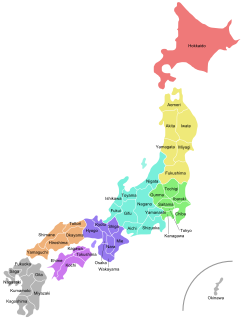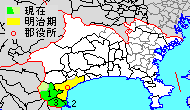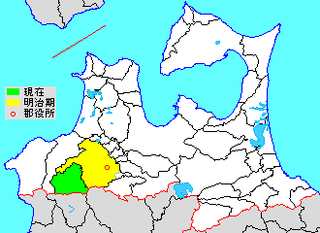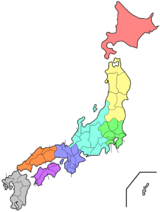
Japan is divided into 47 prefectures, which rank immediately below the national government and form the country's first level of jurisdiction and administrative division. They include 43 prefectures proper, two urban prefectures, one "circuit" or "territory" and one metropolis. In 1868, the Meiji Fuhanken sanchisei administration created the first prefectures to replace the urban and rural administrators in the parts of the country previously controlled directly by the shogunate and a few territories of rebels/shogunate loyalists who had not submitted to the new government such as Aizu/Wakamatsu. In 1871, all remaining feudal domains (han) were also transformed into prefectures, so that prefectures subdivided the whole country. In several waves of territorial consolidation, today's 47 prefectures were formed by the turn of the century. In many instances, these are contiguous with the ancient ritsuryō provinces of Japan.

Musashi Province was a province of Japan, which today comprises Tokyo Metropolis, most of Saitama Prefecture and part of Kanagawa Prefecture. It was sometimes called Bushū (武州). The province encompassed Kawasaki and Yokohama. Musashi bordered on Kai, Kōzuke, Sagami, Shimōsa, and Shimotsuke Provinces.

Shinano Province or Shinshū (信州) is an old province of Japan that is now Nagano Prefecture.

Sagami Province was a province of Japan located in what is today the central and western Kanagawa Prefecture. Sagami bordered on Izu, Musashi, Suruga Provinces; and had access to the Pacific Ocean through Sagami Bay. However, most of the present-day cities of Yokohama and Kawasaki, now part of Kanagawa Prefecture, were not in Sagami, but rather, in Musashi Province. Its abbreviated form name was Sōshū (相州).

Hitotsume-kozō (一つ目小僧) are a Yōkai of Japan that take on the appearance of a bald-headed child with one eye in the center of its forehead similar to a cyclopes.

Ashigarakami District is a district located in western Kanagawa Prefecture, Japan. Most of the mountainous district is sparsely populated, and is part of the Tanzawa-Ōyama Quasi-National Park. Parts of the cities of Hadano and Odawara, and the entire city of Minamiashigara were formerly part of Ashigarakami District.

Ashigarashimo District is a district of Japan located in western Kanagawa Prefecture, Japan. Most of the mountainous district is sparsely populated, and is part of the Fuji-Hakone-Izu National Park. The majority of the area of the city of Odawara was formerly part of Ashigarashimo District.
The Japanese political process has three types of elections: general elections to the House of Representatives held every four years, elections to the House of Councillors held every three years to choose half of its members, and local elections held every four years for offices in prefectures and municipalities. Elections are supervised by Election Administration Commissions at each administrative level under the general direction of the Central Election Management Council, an extraordinary organ attached to the Ministry of Internal Affairs and Communications (MIC). The minimum voting age in Japan's non-compulsory electoral system was reduced from twenty to eighteen years in June 2016. Voters must satisfy a three-month residency requirement before being allowed to cast a ballot.

Nakatsugaru District is a rural district located in Aomori Prefecture, Japan.

Shimokita District is a district located in Aomori Prefecture, Japan. It occupies most of the northern handle of Shimokita Peninsula with the exception of Mutsu City and contains the most northern point on the island of Honshū. It is also home to the Japanese macaque, making it the northernmost natural habitat for monkeys anywhere in the world.
Japan does not recognize same-sex marriages and civil unions. It is the only country in the G7 that does not legally recognize same-sex unions in any form. Several municipalities and prefectures issue symbolic same-sex "partnership certificates" which provide some benefits but do not offer any legal recognition. Most polls conducted since 2013 have found that a majority of Japanese people support the legalization of same-sex marriage or partnerships, and a 2018 poll found it supported by an overwhelming majority of those under age 60.

Iyo Province was an old province of Japan in the area that is today Ehime Prefecture on Shikoku. Iyo bordered on Awa, Sanuki, and Tosa Provinces. It was sometimes called Yoshū (予州).

Shonan Gold (湘南ゴールド) is a hybrid Japanese citrus, with a characteristic "golden" bright yellow color.

The Hyogo Prefectural Assembly is the prefectural parliament of Hyogo Prefecture.
The 2015 Hyōgo prefectural election was an election for the Hyogo Prefectural Assembly held on 12 April 2015 as part of the 2015 unified local elections in Japan. The election saw the number of assembly members reduced from 89 to 87 and the number of electoral districts reduced from 41 to 40. Voting was held in 23 districts and representatives for the remaining 17 districts were elected unopposed. The election was held in the wake of the political expenses scandal that was exposed in July 2014 involving multiple assembly members and was notable for former assemblyman Ryutaro Nonomura's outburst of uncontrolled sobbing at a news conference.
A by-election was held on 31 July 2016 to fill vacancies in four districts of the Tokyo Metropolitan Assembly. The elections were held simultaneously with the gubernatorial election. Nominations for the election were announced on 22 July 2016. Liberal Democratic Party candidates won all four elections.

The Kyoto Prefectural Assembly is the prefectural parliament of Kyoto Prefecture.
Kazuma Nakatani is a Japanese politician, businessman, and judo therapist. He is a member of the House of Representatives belonging to the Constitutional Democratic Party of Japan and the director of its youth bureau. He was previously a member of Kanagawa Prefectural Assembly.
















